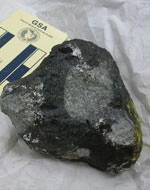
Image credit: University of Chicago
The meteorites that punched through roofs in Park Forest, Ill., on the evening of March 26, 2003, came from a larger mass that weighed no less than 1,980 pounds before it hit the atmosphere, according to scientific analyses led by the University of Chicago?s Steven Simon, who himself also happens to live in Park Forest.
Simon, a Senior Research Associate in Geophysical Sciences at the University of Chicago, and seven co-authors will publish these and other findings in the April issue of the journal Meteoritics and Planetary Science. Simon holds a unique distinction among scientists: his home sits in the middle of the strewnfield, the area from which the meteorites were recovered.
?I don?t know of any other time when a meteoriticist was in the middle of a strewnfield,? said Lawrence Grossman, Professor in Geophysical Sciences at the University of Chicago and one of Simon?s co-authors.
In fact, Simon actually saw the flash the meteorite created. He had the drapes closed when the rock entered the sky over Illinois, but ?the whole sky lit up,? he said.
Grossman, who lives in Flossmoor, not far from Park Forest, also experienced the meteorite?s arrival firsthand. He was awakened by the sound of the meteorite entering the atmosphere that night. ?I heard a detonation,? Grossman said. ?It was sharp enough to wake me up.?
The team calculated the projectile?s size range based on measurements of the galactic cosmic rays that it absorbed. Measurements of a radioactive form of cobalt provided the projectile?s minimum size. ?If the object is too small the cosmic rays will just pass through and not make 60cobalt,? Simon explained.
Simon and Grossman classify the meteorite as an L5 chondrite, a type of stony meteorite, one low in iron that was heated for a long period of time inside its parent body, probably an asteroid. ?It?s a fairly common type of meteorite,? Simon said.
The Park Forest meteorite also showed signs that it had been highly shocked, probably when it was part of a rock that was broken from a much larger asteroid following a collision. The evidence for shock includes shocked feldspar. Apollo astronauts recovered shocked specimens of the mineral from the moon, as well, Simon said. Impact shock was common in the early history of the solar system because of the large quantity of interplanetary debris then in existence.
Witnesses in Michigan, Illinois, Indiana and Missouri reported seeing the fireball that the meteorite produced as it broke up in the atmosphere, Simon and his colleagues reported. Local residents collected hundreds of meteorite fragments totaling approximately 65 pounds from an area extending from Crete in the south to the southern end of Olympia Fields in the north. Located in Chicago?s south suburbs, ?this is the most densely populated region to be hit by a meteorite shower in modern times,? the authors write.
One meteorite narrowly missed striking a sleeping Park Forest resident after it burst through the ceiling of a bedroom. The meteorite sliced through some window blinds, cratered the windowsill, then bounced across the room and broke a mirror before coming to rest.
The meteorites were recovered from a track that trends southeast to northwest. Satellite data analyzed by Peter Brown of the University of Western Ontario indicates that the meteorite traveled from southwest to northeast, however.
?The meteorite broke up in the atmosphere, and the fragments encountered strong westerly winds as they fell,? the authors write. ?The smallest pieces were deflected the furthest eastward from the trajectory, and the largest pieces, carrying more momentum, were deflected the least.?
Contributing to the paper in addition to Simon and Grossman were the University of Chicago?s Robert Clayton and the late Toshiko Mayeda; Jim Schwade of the Planetary Studies Foundation in Crystal Lake, Ill.; Paul Sipiera of Harper College in Palatine, Ill.; John Wacker of Pacific Northwest National Laboratory in Richland, Wash.; and Meenakshi Wadhwa of the Field Museum of Natural History in Chicago.
Their research was supported by grants from the National Aeronautics and Space Administration, the National Science Foundation, and the Planetary Studies Foundation.
Original Source: University of Chicago News Release
